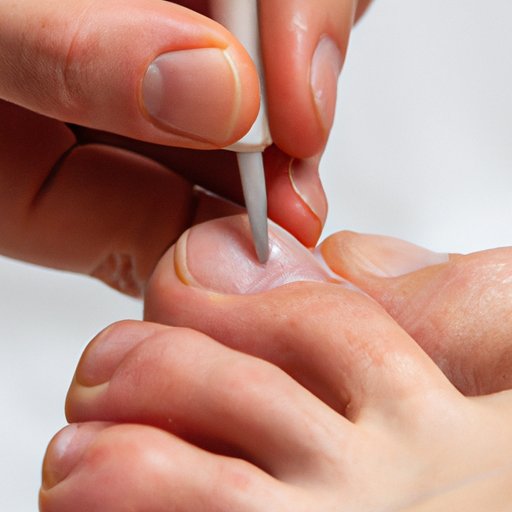
I. Introduction
Ingrown toenails are a common and often painful condition that many people experience at some point in their lives. They occur when the nail grows into the skin surrounding the nail, leading to discomfort, redness, and swelling. While ingrown toenails can be annoying and uncomfortable, they can also cause serious infections if left untreated. In this article, we’ll explore different treatment options for ingrown toenails, including home remedies, over-the-counter treatments, and podiatrist care, and provide practical tips for preventing them in the future.
II. Understanding Ingrown Toenails
Ingrown toenails occur when the nail grows into the skin surrounding the nail, causing discomfort and sometimes infection. They are often caused by improper nail trimming, wearing tight shoes, injury, or genetics. Common signs and symptoms include pain, swelling, redness, and infection. It’s essential to address these symptoms promptly to prevent complications from developing.
III. Home Remedies for Ingrown Toenails
There are various home remedies that can help alleviate the pain and discomfort of ingrown toenails. One option is to soak the affected toe in warm water for 15-20 minutes, 3-4 times per day, to help reduce swelling. You can also gently lift the nail using dental floss or cotton to relieve pressure or apply antibiotic ointment to prevent infection. Wearing open-toed shoes can also help relieve discomfort.
IV. How to Safely Remove an Ingrown Toenail at Home
If you decide to remove an ingrown toenail at home, it’s essential to take safety precautions. It’s recommended to sterilize the tools you’ll use with rubbing alcohol or hydrogen peroxide and carefully trim the ingrown corner of the toenail straight across. You can also use special scissors or nail clippers designed to help remove ingrown toenails. However, it’s crucial to keep an eye on the toe for signs of infection and seek medical attention if necessary.
V. Over-the-Counter Treatment Options
Over-the-counter treatments may help alleviate ingrown toenail symptoms. Medicated ointments, such as Neosporin, can help prevent infection, while bandages can provide cushioning and protection. Toe protectors, like gel caps, can also provide relief from pressure.
VI. Podiatrist Treatment Options
In more severe cases, which may include infection or extreme pain, a podiatrist may recommend surgical options, such as partial nail removal or total nail removal. It’s important to consider any potential risks or side effects associated with these procedures before undergoing them.
VII. Tips for Preventing Ingrown Toenails
Preventing ingrown toenails is a matter of proper nail care and healthy foot maintenance. The first step is to use proper toenail trimming techniques, such as cutting straight across and avoiding cutting the corners too short. Wearing comfortable shoes that fit well and avoiding injury can also help. Removing sweat or moisture with foot powder can also be beneficial for preventing fungal infections.
VIII. Personal Stories and Insights
Individuals who have previously dealt with ingrown toenails often have valuable insights to share. Interviews with these individuals can provide helpful advice, tips, and inspiration for others dealing with this common issue.
IX. Potential Complications
Untreated ingrown toenails can lead to serious infections and further damage to the nail bed. If you experience severe or persistent symptoms, including excessive drainage or pus, fever, or red streaks, it’s essential to seek medical attention to prevent complications.
X. Conclusion
Ingrown toenails can be a frustrating and painful condition, but with proper care, they can be treated and prevented. Home remedies, over-the-counter treatments, and podiatrist care are all viable options, depending on the severity of the condition. Prevention is key, and proper nail care and healthy foot maintenance can help maintain happy, healthy feet.





